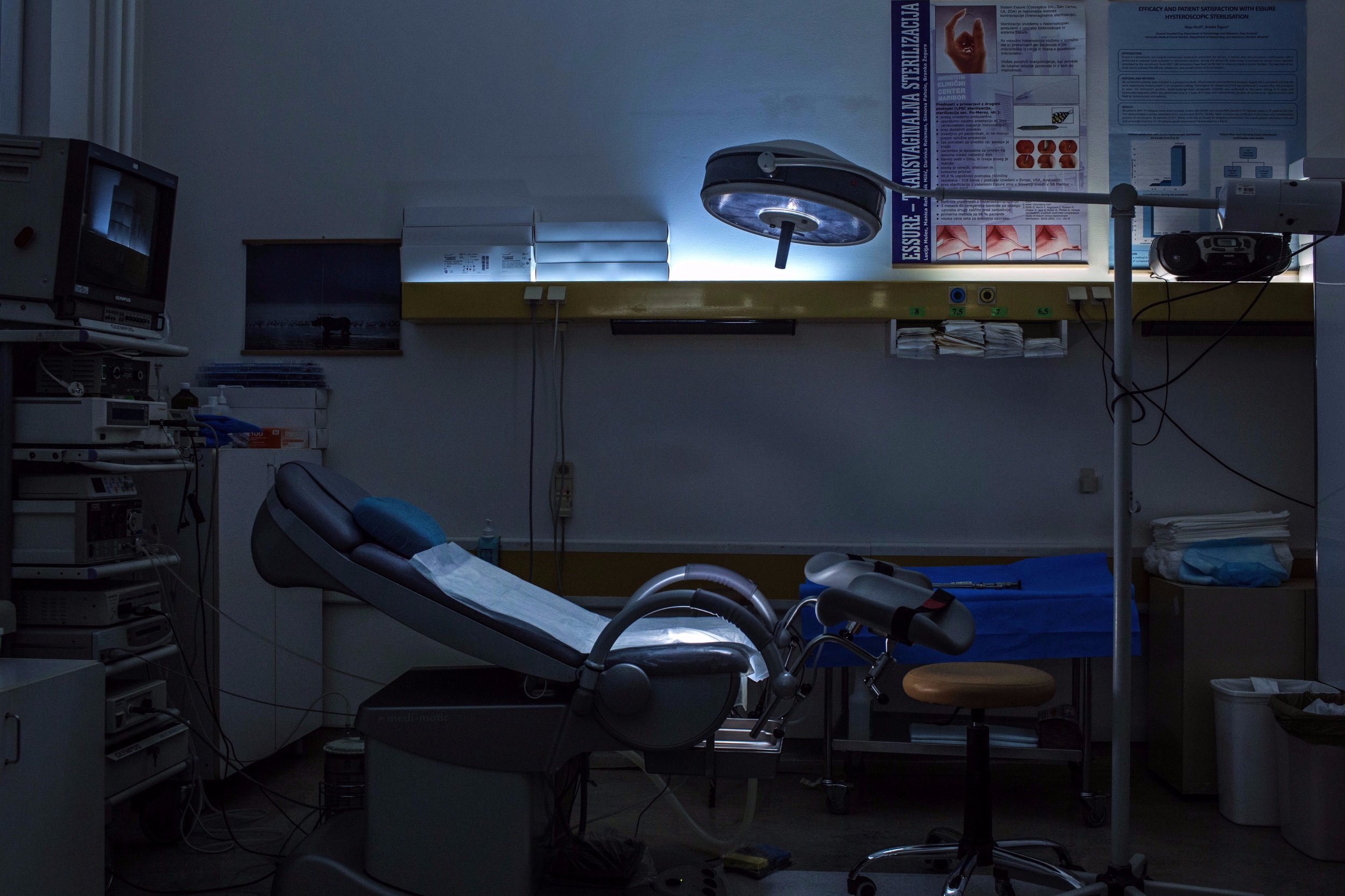Essure, a Luxury Foreign Body
Maja Čakarić
—
The gynaecologist confirmed: the procedure was a success. Mirjana Rajh was done in ten minutes. It was actually not painful, and she really was up and running in no time. Just like she was told. She did not expect any issues.
Contraceptive device Essure. Foto: Matej Povše
She did not hesitate much when deciding on the Essure micro-insert. She was 38 years old and her frequent “issues” mostly involved her two teenage kids. She and her partner decided to not have any more children. And she decided that the right solution is a new and less invasive birth control method.
Only a year earlier, the German pharmaceutical giant Bayer bought Conceptus for $1.1 billion (€970 million), also acquiring company’s contraceptive device Essure. Bayer availed itself of Essure’s reputation and further enhanced it. Essure seemed a perfect story of success. More than a million coil-shaped metal contraceptive devices have been sold around the world to date and, according to data of Slovenian public hospitals, also 1,447 Slovenian women had it implanted in their fallopian tubes.
Mirjana and her partner contemplated different methods of contraception. “Condoms were a no-go, I didn’t like pills which contained hormones, and the Mirena intrauterine system no longer suited me,” she eliminated various options one after another. Bayer’s leaflet was promising.
Today, Mirjana Rajh is one of 11 women in Slovenia who had Essure surgically removed. Twice. Actually, the medical personnel is still not able to tell if they removed it completely or not. Hence, she also has no way of knowing if perhaps some remnants are still floating inside her body.
And they can neither confirm nor deny that her health issues were definitely caused by Essure. Her menstrual cycle was perhaps thrown into disarray due to going through the pre-menopause, while the feeling “as though everything was shifting inside her spine” could coincide with her joining the great big “club” of people with degenerative issues.
“There is a lack of awareness among health care workers about the importance of reporting on adverse events involving medical devices.”
Make hay while the sun shines
Tens of thousands of women on the other side of the Atlantic, several thousand kilometres away from Mirjana Rajh, had similar misgivings. The easily navigable database by the U.S. Food and Drug Administration (FDA) reveals that Bayer’s picture was not entirely rosy.
Since 2002, more than 30,000 reports of adverse event piled up in the database. They primarily referred to stomach pain and irregular menstrual cycle as well as nickel allergy, device migration and – which according to Bayer’s studies happens to 0.2 percent of women with Essure implant – pregnancy.
The database also cites cases of death, either of a foetus or its mother, even though the correlation was not confirmed which means that it is not possible to point the finger directly at Essure.
It is rather meaningful, though, that the FDA first reported five deaths but later acknowledged that it had 296 deaths on file. This data, however, is also incorrect; last year’s analysis showed that there were 303 reports of foetal deaths. In a letter to Congressman Mike Fitzpatrik, the FDA wrote that the difference between 296 and 303 cases was simply “methodological”.
Data on adverse events analysed by the International Consortium of Investigative Journalists (ICIJ) as part of the Implant Files project in 2018 show that almost 8,500 cases of health issues linked directly to the removal of Essure were recorded in the last decade.
Meanwhile, a campaign led by a well-known social activist Erin Brockovich gained momentum in the United States. She loudly demanded that Essure be removed from the market. FDA kept silent. Brockovich pierced the deathly silence with another comment: “If 20,000 men’s penises were falling off, the world would stop.”
When Fitzpatrick intervened, FDA finally budged and took measures. It did not recall the contraceptive device but issued its strictest order to restrict the sale and distribution of Essure and ordered Bayer to conduct a post-marketing clinical study.
Bayer’s representative in Slovenia replied to Oštro that “every contraceptive method entails possible risks and that not everything is for everyone”.
Folded leaflet containing information about Essure.
An elusive culprit
Gabriella Vali Avina, a health worker who previously collaborated with the first Essure manufacturer – the Conceptus company later bought by Bayer – is still contemplating the “not everything is for everyone” adage. She was involved in the first clinical studies before the implant was available on the market. She was also convinced that it “was made for everyone” and was so thrilled about it that she became the “face” of Essure.
This was the reason why for a while she was a thorn in the side of a cohort of women who clearly attributed their health issues to Essure even though the doctors could not undeniably confirm this correlation. Avina knew that a natural alliance between her and this group of women was hardly likely until one day they asked her: “And how has your health been recently?”
That made her wince. It was not until after she was implanted with the birth control device that doctors diagnosed her with celiac disease. Later she was also hospitalized several times due to thyroid dysfunction and even treated with chemotherapy. The only unknown variable in her decade-long equation of ill health was suddenly revealed to her: Essure was a foreign body insider her.
When Oštro asked her if she was informed about possible side effects before the procedure, she tersely replied: “No.” And added: “I know that large medical companies do not provide the public with accurate and true data. Greed is the foundation of their unethical conduct.”
Bayer, against which around 16,000 lawsuits concerning Essure have been filed until now in the United States alone, is withdrawing its contraceptive device from the market mainly in Western countries. Bayer maintains that the reason is not related to the quality or safety of the device but rather “based on a decline in sales in recent years”. In September last year it withdrew Essure also from the European, as well as Slovenian, market. They used it until recently, until the supplies ran out.
In the United States it will not be possible to buy it from 2019 onward, but the doctors will be able to implant it until the end of the year. A large Facebook group of women, over 35,000 members-strong, opposes this measure. And their voices can be heard outside the virtual world. These are the women who asked Gabriella Avina about her health and unknowingly reminded her that she belongs to their camp. Avina got Essure removed and her symptoms were relieved.
Despite recent measures undertaken by Bayer, the leader and founder of the Essure Problems group Angie Firmalino and her »E-sisters« are still knocking on the doors of regulators and are unrelenting in their demands to entirely remove Essure from the market at the start of next year. “We don’t want any more women to be implanted with this device,” she told Oštro.
In September last year Essure was withdrawn from the European, as well as Slovenian, market. They used it until recently, until the supplies ran out. Foto: Matej Povše
Lunch time procedure
Gynaecologist Branka Žegura Andrić was the first doctor who in 2007 brought Essure to University Medical Centre Maribor in Slovenia. After the staff received training provided by instructors of the manufacturer Conceptus, the hospital also acquired a certificate for performing hysteroscopic sterilization.
She was enthusiastic about the implant and regrets it being removed from the market. Patients are still asking about it, she says. And now they also enquire about alternative solutions. Previously they could use Adiana birth control where the procedure involves delivering a low level of radiofrequency energy to a small section of each fallopian tube. This creates a superficial lesion where tiny, soft Adiana inserts are placed. Body’s own tissue then starts to grow around the inserts. This tissue will completely block the fallopian tubes, permanently preventing conception. The results were not good, though. Too many women conceived.
They also researched the hysteroscopic sterilization Ovalastic but were not convinced by the results. Žegura, together with her colleagues, also led several clinical studies which involved Essure. They primarily rated the satisfaction of women and effectiveness of the method.
In her last scientific article co-authored with her colleague she presented an adverse event that involved a perforation of uterus at another hospital. She says that this is a widely known and the most frequent complication with all hysteroscopic procedures.
During her many years of practice, she received visits from five women due to possible adverse events with Essure. One case involved migration of the device, another pain in a patient’s hip which turned out to be sport injury, and one patient reported pain in her finger which soon worn off.
None of these cases were directly linked to Essure. They did operate on one patient to remove the device due to chronic pain in her pelvis. During the procedure they found, however, that she suffered from endometriosis which could also be the cause of pain.
As the gynaecologist says, it is important to keep in contact with patients. A mandatory part of procedure is also a check-up three months after the procedure. And just in case, she provided them with a phone number and e-mail where they can reach her if they experience any issues.
According to Žegura, there is less supervision in the United States when women could buy the Essure implant as though it would be a luxury product. They called it the “lunch time procedure” – one woman could hop in for a Botox injection while the other went in for an Essure procedure. “They were even selling it in drug stores.” It was not until this April that the FDA issued a notice that it can only be purchased by health institutions.
Flawed reporting
In line with the Medical Devices Act, adverse events must be reported within 24 hours to the Agency for Medicinal Products and Medical Devices (JAZMP). On the other hand, reporting such events to manufacturers is optional. According to Oštro’s data, JAZMP mostly receives reports from manufacturers and rarely directly from health care professionals.
JAZMP confirmed that since 2008 to this July they have not received any reports of adverse events involving Essure. They did, however, received seven of them from July to October – only from manufacturers and none from health care workers.
“We find that there is a lack of awareness among health care workers about the importance of reporting on adverse events involving medical devices,” communicated JAZMP. The two Slovenian medical centres and hospitals have 11 adverse events involving Essure logged in their records. Why did not they report them to the JAZMP? The most common explanation is that the nature of adverse events was not related to possible characteristics or quality of the implant.
This system is of no use to Mirjana Rajh and to be honest, she could not be less bothered about it. She is dealing with health issues which affect the quality of her life. And she cannot solve them despite the help of specialists. It could not be Essure, or could it?



